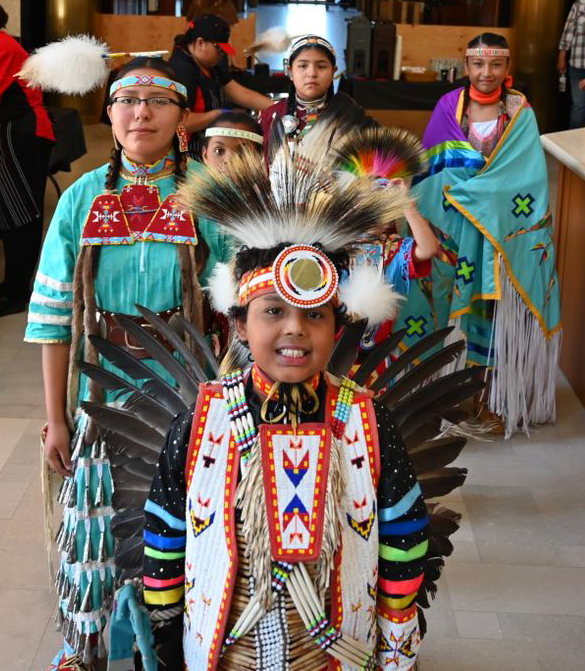New NDDPI Indigenous Education Classroom Resources for SB 2304
Celebrate North Dakota's rich and diverse Indigenous heritage with a selection of new and upcoming resources for your classroom. With Senate Bill 2304 in effect since 2021, the North Dakota Department of Public Instruction has worked with North Dakotan educators of different tribal backgrounds to gather instructional material for our K-12 teachers. NDDPI and its partners have lots of great resources available and are adding more all the time.
What is SB 2304?
North Dakota Senate Bill 2304, passed in 2021, requires all elementary and secondary public and nonpublic schools in the state to include curriculum on Native American history. This includes implementation within the required North Dakota Studies, which provides emphasis on the geography, history, agriculture and the federally recognized Indian tribes in the state, in the fourth and eighth grades. One unit of United States history will include Native American tribal history. You can watch a video summary here.
Where can teachers find resources?
NDDPI's central repository of resources is the Teachings of Our Elders website, which hosts a variety of resources for students K-12, in all content areas. Depending on the grade you teach, the lessons range from classroom activities and textbooks to elder interviews and traditional music.
The North Dakota Department of Public Instruction has partnered with Dr. Scott Simpson and Sharla Steever, experts in educational video production, to create a series of videos. Tribal elders tell traditional stories passed down and some from not that long ago. The series splits up its interviews evenly between the tribal nations in North Dakota, so you'll have something local to show students, no matter where you are in the state. These are available on the program's official YouTube channel, ND Elder Teachings.
Who is developing the curriculum material?
The Indigenous Education Coalition is the curriculum development committee. This registered non-profit was founded in 2022 in response to SB 2304 and is based in Mandan, ND. The members come from a wide range of tribal and professional backgrounds. They are working with the North Dakota Historical Society, which runs the broader North Dakota Studies program, to create and update instructional materials. Additional materials can be found on the ND Studies Tribal Curriculum page.
How are the textbooks being updated?
In the 1990s, North Dakota's tribal colleges each wrote a textbook about their respective nation. The best way to ensure authenticity is, after all, to get your information straight from the source. This series brings their deep understanding into your hands. NDDPI is proud to announce that we are working with the North Dakota Tribal College System again to update these books. We are in the process of digitizing these resources so the colleges' historians can expand and revise them, with assistance from the University of North Dakota Chester Fritz Library. Printed books will be provided to North Dakota schools and available for sale to the public. Ebook versions will also be available free of charge. The texts will also be uploaded to the Digital Commons Network, a free repository of scholarly work, giving the world access to these first-hand accounts of the past and present.

The volumes in this series are: 1) History & Culture of the Mandan Hidatsa & Sahnish (Arikara), 2) History & Culture of the Mni Wakan Oyate Spirit Lake Nation, 3) History & Culture of the Standing Rock Oyate, and 4) History & Culture of the Turtle Mountain Band of Chippewa.
How else is NDDPI engaged in this effort?
The North Dakota Department of Public Instruction hosted 9th annual Indian Education Summit held in the Capitol building on 7 July 2023. Over 150 educators from across the state attended presentations to deepen their understanding of the state's cultural heritage. Attendees learned how to interpret student behavior and mannerisms through the lens of local tribal cultures, how to help students feel comfortable and safe in the classroom, and the sorts of traditional family arrangements teachers may encounter (or, more likely, have already encountered, but may not have had a framework for understanding). A cultural presentation was given by award-winning traditional dancers, who also happen to be students in North Dakota K-12 schools. A traditional meal was prepared by the talented food service staff of United Tribes Technical College, giving attendees a taste of North Dakota cuisine with locally sourced ingredients. NDDPI gave a presentation on the state of the textbook update project.

How can teachers use this material?
One of the best ways to incorporate the resources available is to put them into context with other lessons. A social studies class could have students pick an elder interview video and research the cultural context, writing a report on the events and situations mentioned in the story. An art class could have an assignment where students try their hand at beadwork. A life skills class that teaches cooking could include a traditional recipe from a nearby nation, alongside info on how the recipe has evolved as ingredients and technology changed. A biology test could award a bonus point whenever a student knows the name for a mentioned plant or animal in a local Indigenous language. Tying classwork back to the culture around them can engage students on a social level, rather than just an academic one.
Legal Disclaimer:
EIN Presswire provides this news content "as is" without warranty of any kind. We do not accept any responsibility or liability for the accuracy, content, images, videos, licenses, completeness, legality, or reliability of the information contained in this article. If you have any complaints or copyright issues related to this article, kindly contact the author above.
